![]()
![]()
![]()
Use LEFT and RIGHT arrow keys to navigate between flashcards;
Use UP and DOWN arrow keys to flip the card;
H to show hint;
A reads text to speech;
84 Cards in this Set
- Front
- Back
|
What does AVP do?
|
activates passive reabsorption in the collecting duct
If there is no gradient, there is no waterflow |
|
|
What is the hallmark feature of SIADH?
|
hyponatremia; d/t excessive dilution from excess water retention
|
|
|
What are some causes of SIADH
|
"inflammation or obstruction" of lungs or cerebral (sellar tumor, TB, aspergillosis)
Drugs:Antidepressives, anticonvulsants, opioids, chemo drugs |
|
|
What is the volume status in SIADH
|
Euvolemic
|
|
|
What is the serum osmolality in SIADH?
|
Hypotonic (<275 mOsm/L)
|
|
|
What are the required criteria for SIADH?
|
Euvolemic (normal blood volume)
The serum sodium and serum osmolality are low Urine Osmolality >100 (holding onto water since there is a low serum Osm!) Urine sodium >20mEq/L Hypothyroidism and adrenal insufficiency need to be ruled out (it is a diagnosis of exclusion) |
|
|
How do you treat SIADH?
|
first treat the cause (sometimes it is idiopathic)
IV salt solution (has to be greater osmolarity than urine) Vasopressin Receptor Antagonists (conivaptan and talvaptan) Loop diuretics (furosemide and bumetanide; directly diminish concentration gradient) Demeclocyline-->inhibits the collecting tubules response to AVP |
|
|
Deficient production/release of AVP
|
Central Diabetes Insipidus
|
|
|
Causes of Central DI
|
Autoimmune injury to the hypothalamus/pituitary
Head trauma/surgery Infiltrative disorders (sarcoidosis, histiocytosis) Tumors |
|
|
Renal resistance to AVP
|
Nephrogenic DI
|
|
|
Causes of Nephrogenic DI
|
X-linked recessive disorders
Hypokalemia Hypercalcemia Renal Diseases Drugs (Lithium) |
|
|
Urine Osmolarity in DI
|
Low (<300 mosm/kg); polyuria; perform a water restriction test
|
|
|
Plasma osmolarity in DI
|
higher (>300 mosm/kg); determined after water restriction test
|
|
|
In Central DI how does the H20 Deprivation test work?
|
With water deprivation, the urine osmolaity will slightly increase (not as much as normal) and with administration of AVP (desmopressin) you see a response
|
|
|
In Nephrogenic DI how does the H20 depreivation test work
|
There is NO change in urine osmolaity even with administration of desmopressin
|
|
|
Treatment of central DI
|
Replace the missing hormone with a synthetic form of ADH called DDAVP (Desmopressing, 1-deamino-8-D-arginine vasopressin)
|
|
|
Treatment for Nephrogenic DI
|
Recommend a low salt, low protein diet (limiting solute potentially lowers urine volume)
Start a THIAZIDE (Amiloride) diuretic NSAIDs (inhibit renal prostaglandins; limits prostaglandin interference with AVP) Some might even have a response to DDAVP |
|
|
Where does most of your dietary iodine go?
|
To your kidneys/urine
Only a small amount goes to your thyroid |
|
|
If TBG increases
|
Free T4 decreases, and TSH increases, and more T4 is released from thyroid-->leads to a greater amount of total T4 and a normal free T4 and TSH
In equilibrium |
|
|
Congenital hypothyroidism epidemiology
|
More common ins Hispanics/asians/native americans
More common in girls |
|
|
What are the potential causes of Congenital hypothyroidism?
|
Absent thyroid or small ectopic thyroid (dysgenesis; might not descent appropriately)
Iodine deficiency (most common worldwide but rare in US) Central hypothyroidism (multiple pituitary hormone disease; or the hypothalamus not producing TRH) Transient: Late maturation, Antibodies from mom (block TSH receptor), Drugs |
|
|
Presentation of congenital hypothyroidism?
|
Most infants are ASYMPTOMATIC at birth (need to screen)
If untreated: lethargic, hoarse cry, feeding problems, constipation, hypotonia, chubby, developmental delay, hypothermia, large fontanels |
|
|
Newborn screening tests of congenital hypothyroidism
|
Measure T4 and TSH; Mostly rely on the high values of TSH (it might be inappropriately normal)
|
|
|
False positives for congenital hypothyroidism occur mainly because?
|
Delayed TSH rise
|
|
|
Treatment of Congenital Hypothyroidism
|
Levothyroxine (T4); Serum free T4 should be kept in the upper range of normal during first year of life)
Especially important to treat in first 3 years of life d/t developmental implications |
|
|
Primary Hypothyroidism acts where?
|
on the thyroid
|
|
|
2ndary hypothyroidism acts where?
|
On the anterior pituitary
|
|
|
Sensitizatoin of the host's own lymphocytes to various thyroidal antigens including thyroglobulin, thyroid peroxidase, and the TSH receptor
|
Hashimoto's Thyroiditis
|
|
|
Hashimoto's Thyroiditis is d/t
|
Viral/bacterial infection
High iodine intake defects in suppressor T lymphocytes (genetic factors) all can be responsible for the autoimmune process |
|
|
Create a differential diagnosis for primary hypothyroidism
|
Iodine excess (Wolff-Chaikoff effect)
Antithyroid agents Lithium Hashimoto's Thyroidectomy |
|
|
Create a differential diagnosis for 2ndary hypothyroidism
|
Tumors
Dopamine Glucocorticoids Sarcoidosis |
|
|
What are the clinical features of hypothyroidism
|
Hair loss
Fatigue Weight Gain Periorbital puffiness Macroglossia Hoarseness Bradycardia Non-pitting edema Delayed relaxion of ankle jerks |
|
|
How to you diagnose adult hypothyroidism
|
Serum TSH; much more sensitive
|
|
|
TSH levels in Primary and 2ndary hypothyroidism
|
Primary-->High (positive thyroglobulin antibodies)
Secondary-->low or inappropriately normal (negative thyroglobulin antibodies) |
|
|
Tx for Hashimoto's
|
Levothyroxine (T4) or Liothyronine (T3)
You cant treat the actual cause of Hashimoto's |
|
|
Signs and Sx of Graves (Hyperthyoidism)
|
Anxious, palpitations, voracious appetite, weight loss, Heat intolerance
Fine tremor, moist, thickened skin (usually over pretibial area-usually d/t mucopolysaccharide deposition), lid lag, stare, Propptosis, Tachycardia |
|
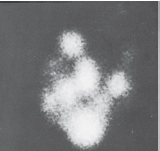
Radiotracer uptake
|
Toxic multinodular goiter
multiple functioning thyroid nodules |
|
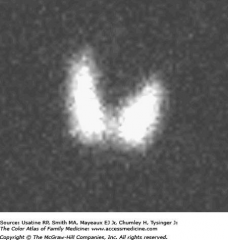
Radiotracer Uptake
|
Nuclear Scan of Graves' disease
|
|
|
131-Iodine
|
thyroid destruction of an overactive or enlarged thyroid; deposited in colloid emitting both gamma rays and beta particles destroying parenchymal cells of thyroid (high incidence of delayed hypothyroidism)
|
|
|
Methimazole
|
Tx for hyperthyroidism; safer, less side effects; blocks the oxidation of iodine (one side effect is granulocytosis)
|
|
|
Propylthiouracil
|
Tx in Hyperthyroidism; Used in PREGNANT women/or intolerance of methimazole; blocks the oxidation of iodine and also inhibits deiodination of T4 to T3 (can cause hepatic failure)
|
|
|
Iodine
|
-->use in combo with other drugs and propranolol in the tx of thyrotixic crisis; can also protect the thyroid from radioactive iodine fallout; inhibits hormone release; also decreses the vascularity size and fragility of a hyperplastic gland
|
|
|
Treatment in "thyroiditis"
|
Beta, blockers and supportive care
|
|
|
High iodine uptake? Graves or Thyroiditis?
|
Graves disease
|
|
|
If T4 and TSH are both high what is the next step in Tx?
|
MRI sella, find pituitary adenoma, surgery
|
|
|
Microscopic features of Hashimoto's thyroiditis
|
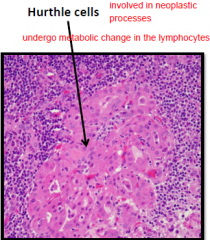
Lymphocytic inflammation, Germinal centers, Hurthle cell change
|
|

|
Germinal centers in Hashimoto's Thyroiditis
|
|
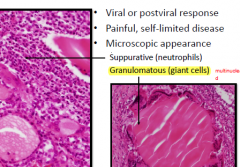
|
Subacute Thyroiditis (de Quervain)
|
|
|
Fibrous Riedel Thyroiditis
|
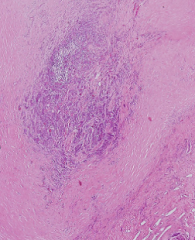
Hard and fixed thyroid, painless, Microscopic appearance, Dense fibrosis (collagen fibers); Fibrosis can extend outside of thyroid
|
|
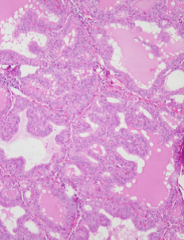
|
Graves Disease; Abnormal shaped follicles; Scalloped colloid
|
|
|
Follicles lined by crowded columnar cells; variable sized follicles, abundant colloid, initial stages-->diffuse enlargement
|
Goiter
|
|

|
Nodular Hyperplasia
|
|
|
Majority are non-neoplastic (focal hyperplasia or simple cysts) or benign (adenomas)
|
Solitary Palpable thyroid nodules
|
|
|
Can be diagnostic in papillary carcinoma, madullary carcinoma, lymphoma and metastatic tumors but CANNOT differentiate follicular adenoma from follicular carcinoma or from hyperplastic nodules
|
Fine needle Aspiration
|
|
|
Characteristics of Follicular adenomas
|
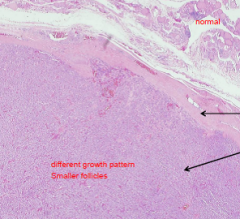
Solitary
Completely surrounded by a FIBROUS CAPSULE Different growth pattern from adjacent normal gland Variable appearances |
|
|
Most significant proven risk factor for development of thyroid cancer
|
Ionizing radiation
|
|
|
Most common type of thyroid cancer
|
Papillary CA-->85%-95%
|
|
|
Mutations/chromosomal abnormalities in Thyroid papillary carcinoma
|
BRAF oncogene
RAS Inv(10) t(10;17) |
|
|
Mutation in follicular thyroid carcinoma
|
RAS oncogene
|
|
|
Mutation in Anaplastic Thyroid Cancer
|
p53 tumor suppressor
|
|
|
Epidemiology of Papillary thyroid cancer
|
Most occur in younger age group (20s-40s)
Metastasize by way of lymphatics to regional lymph nodes Excellent prognosis |
|
|
Histology of Papillary Carcinoma
|
NUCLEAR FEATURES!
Clear nuclei-->Orphan Annie Eyes Intranuclear cytoplasmic inclusions Intranuclear grooves |
|
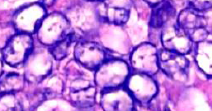
|
Orphan annie nuclei (papilary carcinoma)
|
|
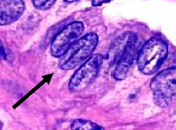
|
Longitudinal nuclear grooves (papillary carcinoma)
|
|
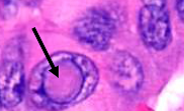
|
Intranuclear Pseudoinclusions (papillary carcinoma)
|
|
|
Second most common thyroid cancer
|
Follicular Thyroid Carcinoma
|
|
|
Features of thyroid carcinoma
|
Older age than papillary (40s to 50s)
Slowly enlarging painless nodule Vascular spread to bone, lungs, liver Generally worse prognosis than papillary carcinoma |
|
|
Criteria for Malignancy of follicular carcinoma
|
Capsular invasion
Vascular invasion Need extensive sampling of the capsule |
|
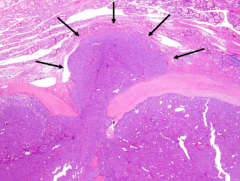
|
Follicular Carcinoma-Capsular invasion
|
|

|
Follicular Carcinoma-Vascular invasion
|
|
|
What is the main cause of follicular carcinoma?
|
Nodular Goiter
|
|
|
Metastatic Spread of Follucular Carcinoma
|
Hematogenous to lung, liver, and bone
(papillary goes to lymph nodes) |
|
|
Neuroendocrine tumors derived from the parafollicular (C-cells) of the thyroid
Secrete Calcitonin |
Medullary Carcinoma
|
|
|
Causes of Medullary Carcinoma
|
80% are sporadic
20% occur within families (MEN-2 syndrome) |
|
|
Histologic features of Medullary carcinoma
|
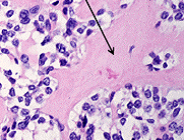
Nests of neuroendocrine cells
Amyloid Stroma (picture) |
|

|
Nest of neuroendocrine cells; Medullary carcinoma
|
|
|
What main antibody is stained against in Medullary carcinoma
|
Calcintonin
|
|
|
Ugly, unifferentiated tumor of the follicular epithelium
|
Anaplastic Carcinoma
|
|
|
Epidemiology/prognosis of Anaplasic carcinoma
|
65 yo
May have a history of long-standing goiter, differentiated thyroid carcinoma or concurrent papillary carcinoma Most have extrathyroidal spread or distant metastiasis pat presentation Mortality rate is 100%!!! 6 month survival Spindle cell and epitheloid type |
|
|
What is the primary determinant of free water excretion in humans
|
ADH circulating levels
|
|
|
What is the major factor controlling AVP release?
|
Plasma osmolality; a small 1% rise in plasma osmolality stimulates AVP release by a detectable amount
The change in volume or pressure is less sensitive (need 10-15% drop), but once it reaches a threshold, the stimulated response is exponential |
|
|
Where is the nephron is the primary site of AVP response?
|
The collecting duct
|
|
|
In SIADH, what determines the symptoms?
|
depend on the rate of onset and degree of hyponatremia
|
|
|
Primary polydopsia
|
Psychiatric disorder: persistent consumption of oral fluids results in appropriate diuresis that resembles high urine volumes
|

